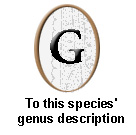

|
Photo Gallery- Haughton Crater Photo Gallery- Forensic Nematology |
Body moderately curved ventrally when relaxed. Body increases
in diameter from lips to base of esophagus 3.0 + .4 times.
Lip width 14.7 m and set off from body by weak to fairly strong constriction.
Lips angular with pointed papillae protruding moderately. Amphids
obscure. Cuticle weakly annulated; thickness at mid-body 2.0 m +
.4. Cuticle thickness at head same as at mid-body; thickness at tail
twice as great. Cuticle divided into thin outer layer and thick inner
layer. Lateral cord width 13 m + 1.
Spear length 17.2 m + 1.9. Width of spear 1.9 m +
.3. Spear aperture and extensions obscure. Guiding sheath
slightly everted when spear is completely retracted; anterior attachment
of sheath ring-like. Esophagus enlarges gradually between narrow
anterior and wide posterior portions; enlargement begins at 45% +
2 from esophagus base. Cardial conical; 8-15 m long. Intestinal
cells obscure. Rectum length of four females 23 m + 3.
Prerectum length of same four females 43 m + 17. Anal body
diameter 25 m + 3. Tail arcuate-conical with subacute
tip. Tail curved ventrally 30-120 degrees from body axis. Caudal
papillae obscure.
Anterior and posterior gonads 10% + 3 of body length in four
females; reflexed 60-90%. Vulval labia with rectangular sclerotized
pieces. No eggs observed.
Male: Unknown.
Habitat. Chochotahska, Poland.
There are an unusually large number of species which closely resemble E. silvaticus. These species are E. brevis, E.fransus, E. humilis, E. incisus, E. piracicabensis, E. noterophilus, E. meridionalis, E. indianensis, and E. aquilonarius. They differ from E. silvaticus as follows: E. brevis has vulva more (P<1%) posterior, body narrower (P<5%); E. fransus has “b” value larger (P<1%), lips narrower (P< 5%), and spear shorter (P<5%); E. humilis has “c” value smaller (P<1%), spear shorter (P<.1%), and body diameter increases less from lips to base of esophagus (P<1%); E. incisus has esophagus shorter (P<.1%), lateral cords narrower (P<1%), and anal body diameter narrower (P<1%); E. piracicabensis has “a” value smaller (16 and 19 vs. 22-31) and lips strongly set off vs. weakly to fairly strongly set off; E. noterophilus has anal body diameter narrower (P<1%) and tail longer (P<1%), and body diameter increases less from lips to base of esophagus (P<1%); E. aquilonarius has body narrower (P< 1%), body diameter increasing less (P<1%) from lips to base of esophagus, and anal body diameter narrower (P<1%).
DNA Sequences Obtained
| Specimen: | Collected: |
| Crater03Bin-83 | Haughton Crater Survey |
| Konza IIBC-80 | Konza Prairie, First survey |
| Konza IIAC-44 | Konza Prairie, First survey |
| Konza IIIBD-32 | Konza Prairie, First survey |
| Konza IIICD-41 | Konza Prairie, First survey |
| Konza IIFF-133 | Konza Prairie, First survey |
 |
 |